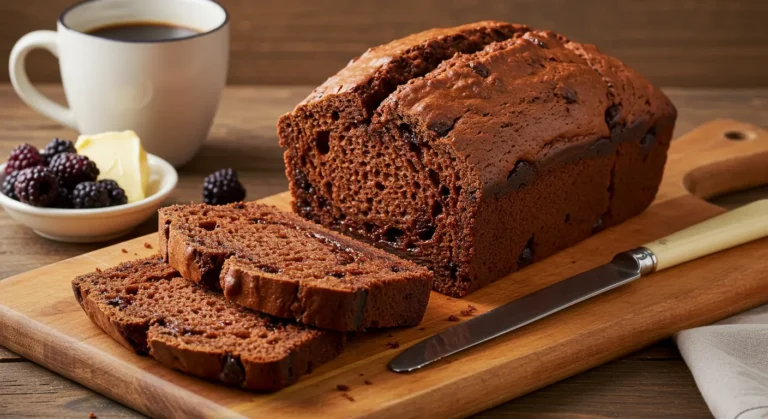Best Almond Croissant for a Bakery-Style Breakfast
How many home bakers attempt to recreate their favorite bakery treats only to find that certain recipes remain elusive masterpieces? The almond croissant, that buttery, flaky pastry filled with rich almond cream, tops the list of most-attempted yet rarely mastered bakery classics—ranking as the third most challenging pastry to perfect at home according to professional bakers. This guide unlocks the secrets to creating authentic almond croissants that rival those from upscale French patisseries, transforming your kitchen into a destination bakery for this beloved breakfast delicacy.
Table of Contents
Ingredients List
For the croissants:
- 6 large, day-old plain croissants (slightly stale works best as they absorb the syrup without becoming soggy)
- Store-bought croissants work perfectly, or use homemade if you’re feeling ambitious
For the simple syrup:
- ½ cup granulated sugar
- ½ cup water
- 1 tablespoon rum or brandy (optional, can substitute with 1 teaspoon vanilla extract for alcohol-free version)
For the almond cream (frangipane):
- 1 cup (200g) unsalted butter, softened
- 1 cup (200g) granulated sugar
- 2 cups (200g) almond flour/ground almonds
- 4 large eggs, room temperature
- 2 tablespoons all-purpose flour
- ½ teaspoon almond extract
- ¼ teaspoon salt
For topping:
- ⅓ cup sliced almonds
- 2 tablespoons powdered sugar for dusting
- Optional: pearl sugar for extra crunch and visual appeal
Timing
Creating bakery-quality almond croissants requires attention to timing:
- Preparation time: 25 minutes
- Resting/cooling time: 30 minutes
- Baking time: 15-18 minutes
- Total time: 70-75 minutes
Step-by-Step Instructions
H3: Step 1: Prepare Your Work Area and Ingredients
Begin by organizing your workspace and gathering all ingredients. Slice your day-old croissants horizontally, keeping them connected at one edge like a book—this creates the perfect pocket for the almond cream while maintaining the croissant’s structure. Place them on a parchment-lined baking sheet. Professional bakers prefer slightly stale croissants for this recipe as they better absorb the syrup without collapsing.
H3: Step 2: Create the Simple Syrup
In a small saucepan, combine the water and sugar over medium heat. Stir occasionally until the sugar completely dissolves, about 3-4 minutes. Once dissolved, remove from heat and stir in the rum or vanilla extract. Allow the syrup to cool until just warm to the touch—around 110°F (43°C) is perfect, as it will soak into the croissants effectively without making them soggy. The syrup adds moisture and a subtle complementary flavor that enhances the almond notes.
H3: Step 3: Prepare the Almond Cream (Frangipane)
In a large bowl, cream together the softened butter and sugar until light and fluffy, about 3-4 minutes using an electric mixer. This aeration creates a lighter, more delicate almond cream. Add the eggs one at a time, fully incorporating each before adding the next—this prevents curdling and ensures a smooth texture. Mix in the almond flour, all-purpose flour, almond extract, and salt until just combined. The ideal frangipane should be spreadable but hold its shape, similar to the consistency of thick cake batter.
H3: Step 4: Assemble the Almond Croissants
Open each croissant like a book and generously brush both interior sides with the simple syrup, using about 1-2 tablespoons per croissant. This step rehydrates the pastry while adding subtle sweetness. Then, spread approximately 2-3 tablespoons of almond cream on the bottom half of each croissant, leaving a small border around the edges to prevent overflow during baking. Close the croissants and spread another tablespoon of almond cream on top—this is the signature feature of authentic almond croissants that many home bakers miss.
H3: Step 5: Add the Finishing Touches
Sprinkle the sliced almonds over the almond cream topping, gently pressing them in so they adhere during baking. For truly authentic almond croissants, ensure the almonds cover most of the surface—professional bakers use about 2 teaspoons of sliced almonds per croissant. Allow the assembled croissants to rest for 15-20 minutes while you preheat your oven to 350°F (175°C). This resting period allows the flavors to begin melding and helps the frangipane set slightly.
H3: Step 6: Bake to Golden Perfection
Bake the prepared almond croissants in the preheated oven for 15-18 minutes, or until the almond cream is set and the tops are golden brown. Position the rack in the middle of the oven for even heat distribution—this prevents burning the almonds before the filling is properly set. Every oven varies, so start checking at the 12-minute mark, looking for a rich golden color and slightly bubbling almond cream.
H3: Step 7: Cool and Finish
Remove the almond croissants from the oven and allow them to cool on the baking sheet for 10 minutes. Transfer to a wire rack to cool completely, about 20 more minutes. Just before serving, dust generously with powdered sugar using a fine-mesh sieve for the most even application. This final touch not only adds sweetness but creates that distinctive bakery-style appearance that makes almond croissants instantly recognizable.
Nutritional Information
- Calories: 520 per croissant
- Total Fat: 35g
- Saturated Fat: 18g
- Trans Fat: 0g
- Cholesterol: 150mg
- Sodium: 280mg
- Total Carbohydrates: 42g
- Dietary Fiber: 3g
- Sugars: 22g
- Protein: 9g
Healthier Alternatives for the Recipe
Transform this classic indulgence into a more nutritious breakfast recipe with these thoughtful modifications:
- Reduce sugar in the frangipane to ¾ cup and in the simple syrup to ⅓ cup for a less sweet version that still delivers authentic flavor.
- Substitute part of the butter with Greek yogurt (use ¾ cup butter and ¼ cup Greek yogurt) to reduce saturated fat while maintaining moisture and richness.
- For gluten-sensitive individuals, seek out gluten-free croissants as your base—many specialty bakeries now offer these alternatives.
- Incorporate 2 tablespoons of ground flaxseed into the almond cream for added omega-3 fatty acids and fiber without significantly altering the taste.
- Use coconut sugar instead of granulated sugar for a less refined sweetener with a lower glycemic index.
- For dairy-free almond croissants, substitute the butter with a high-quality plant-based butter alternative that’s designed for baking.
Serving Suggestions
Elevate your almond croissant experience with these creative serving ideas:
- Create an elegant breakfast board by pairing warm almond croissants with fresh berries, honey-drizzled Greek yogurt, and a small pot of orange marmalade or raspberry preserves.
- For a café-style breakfast, serve your almond croissant alongside a frothy cappuccino in a warmed mug—the coffee’s slight bitterness perfectly balances the pastry’s sweetness.
- Transform your almond croissant into a decadent dessert by warming it slightly and serving with a scoop of vanilla bean ice cream and a drizzle of warm chocolate sauce.
- For brunch gatherings, create an almond croissant bread pudding by cutting leftover pastries into chunks, soaking in custard, and baking until golden and puffy.
- Complement the almond flavor by serving alongside a small dish of amaretto-macerated cherries or stone fruits when in season.
Common Mistakes to Avoid
Master the art of perfect almond croissants by avoiding these common pitfalls:
- Using fresh croissants: Day-old croissants absorb the syrup more effectively without becoming soggy. Fresh croissants often become too moist and lose their structural integrity.
- Overfilling with almond cream: While generosity is tempting, using more than 3-4 tablespoons of frangipane per croissant causes overflow during baking. Expert pastry chefs recommend filling to just 80% capacity.
- Skipping the top layer of almond cream: Authentic almond croissants have frangipane both inside and on top—this double application creates the signature taste and appearance.
- Baking at too high a temperature: Above 375°F, the almonds and exterior burn before the filling sets. Lower, slower baking (350°F) ensures even cooking.
- Applying powdered sugar while warm: This causes the sugar to melt and disappear. Wait until croissants have cooled completely for that classic white dusting effect.
- Rushing the cooling process: Allowing proper cooling time (at least 30 minutes) lets the flavors develop and textures set properly—professional bakers consider this mandatory, not optional.
Storing Tips for the Recipe
Properly storing almond croissants preserves their flavor and texture:
- Same-day storage: If enjoying within 24 hours, store completely cooled almond croissants in an airtight container at room temperature. Place parchment paper between layers to prevent sticking.
- Short-term refrigeration: For 2-3 day storage, place in an airtight container in the refrigerator. Before serving, reheat in a 300°F oven for 5-7 minutes to restore crispness.
- Freezing baked croissants: Wrap individual, completely cooled almond croissants tightly in plastic wrap, then aluminum foil. Freeze for up to 2 months. Thaw overnight in the refrigerator, then reheat at 300°F for 8-10 minutes.
- Make-ahead preparation: Assemble the almond croissants up to the point of baking, then freeze on a baking sheet until solid. Transfer to airtight containers and store frozen for up to 1 month. Bake directly from frozen, adding 5-7 minutes to the baking time.
- Storing almond cream: Excess frangipane can be refrigerated for up to 3 days or frozen for up to 1 month in an airtight container. Bring to room temperature before using.
Conclusion
These bakery-style almond croissants deliver the perfect balance of buttery layers, rich almond filling, and delicate sweetness for an extraordinary breakfast experience. By following these precise techniques and using quality ingredients, you’ve mastered a French pastry classic that transforms ordinary mornings into special occasions. The combination of flaky texture and aromatic almond flavor creates an unforgettable culinary delight.
We’d love to hear about your experience making these almond croissants! Share your results, questions, or creative adaptations in the comments section below. Don’t forget to bookmark this page for your next special breakfast or brunch gathering.
FAQs
Q: My almond cream seems too runny. What went wrong? A: Runny almond cream usually results from butter being too warm or eggs added too quickly. If this happens, refrigerate the mixture for 15-20 minutes to firm it up before proceeding. For future batches, ensure your butter is softened but still cool to the touch.
Q: Is there a non-alcoholic substitute for the rum in the simple syrup? A: Vanilla extract makes an excellent alcohol-free alternative. You can also use orange flower water (use half the amount) or 2 teaspoons of fresh lemon zest for different but complementary flavor profiles.
Q: Why are my almonds burning before the croissant is fully baked? A: If the almonds are browning too quickly, loosely cover the croissants with aluminum foil after the first 10 minutes of baking. This protects the top while allowing the filling to finish cooking properly.
Your Feedback Matters
There are no reviews yet. Be the first one to write one.







